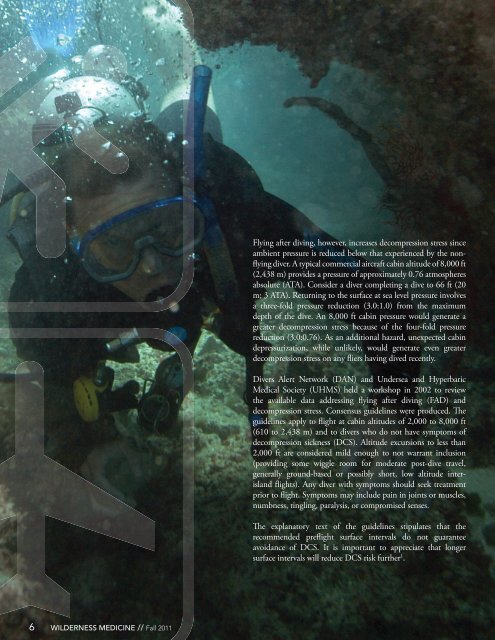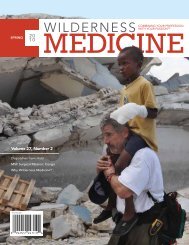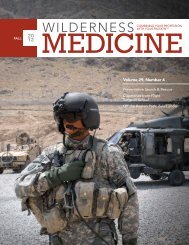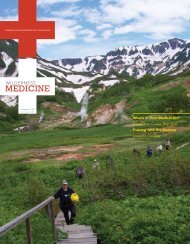Volume 28, Number 4 - Wilderness Medical Society
Volume 28, Number 4 - Wilderness Medical Society
Volume 28, Number 4 - Wilderness Medical Society
You also want an ePaper? Increase the reach of your titles
YUMPU automatically turns print PDFs into web optimized ePapers that Google loves.
Flying after diving, however, increases decompression stress since<br />
ambient pressure is reduced below that experienced by the nonflying<br />
diver. A typical commercial aircraft cabin altitude of 8,000 ft<br />
(2,438 m) provides a pressure of approximately 0.76 atmospheres<br />
absolute (ATA). Consider a diver completing a dive to 66 ft (20<br />
m; 3 ATA). Returning to the surface at sea level pressure involves<br />
a three-fold pressure reduction (3.0:1.0) from the maximum<br />
depth of the dive. An 8,000 ft cabin pressure would generate a<br />
greater decompression stress because of the four-fold pressure<br />
reduction (3.0:0.76). As an additional hazard, unexpected cabin<br />
depressurization, while unlikely, would generate even greater<br />
decompression stress on any fliers having dived recently.<br />
Divers Alert Network (DAN) and Undersea and Hyperbaric<br />
<strong>Medical</strong> <strong>Society</strong> (UHMS) held a workshop in 2002 to review<br />
the available data addressing flying after diving (FAD) and<br />
decompression stress. Consensus guidelines were produced. The<br />
guidelines apply to flight at cabin altitudes of 2,000 to 8,000 ft<br />
(610 to 2,438 m) and to divers who do not have symptoms of<br />
decompression sickness (DCS). Altitude excursions to less than<br />
2,000 ft are considered mild enough to not warrant inclusion<br />
(providing some wiggle room for moderate post-dive travel,<br />
generally ground-based or possibly short, low altitude interisland<br />
flights). Any diver with symptoms should seek treatment<br />
prior to flight. Symptoms may include pain in joints or muscles,<br />
numbness, tingling, paralysis, or compromised senses.<br />
The explanatory text of the guidelines stipulates that the<br />
recommended preflight surface intervals do not guarantee<br />
avoidance of DCS. It is important to appreciate that longer<br />
surface intervals will reduce DCS risk further 1 .<br />
6 WILDERNESS MEDICINE // Fall 2011















